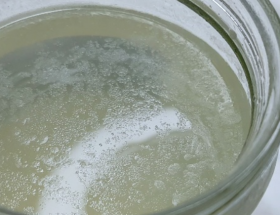In October, I started a personal protective style challenge to improve my length retention and the overall health of my hair. One strategy that I have for success is to do away with commercial shampoos and instead use naturally derived shampoos to cleanse my protective style each week. These natural cleansers must have the same consistency as a tea rinse so that I don’t experience build up when I wash my protective hairstyles. In the first month, I used the water washing method and honey washes, but I wanted something more. During my research, I came across herbal and other alternative shampoos, including soapwort root shampoo. I was intrigued to learn how it could be used on my natural 4c hair.
What Is Soapwort Root?
Soapwort (Saponaria officinalis) is a perennial herb that is part of the carnation family. It’s also known as Bouncing Bet and soapweed and is originally native to Southern and Central Europe, Asia Minor and Western Siberia. It was eventually introduced as a garden plant to North America and other parts of the world.
This herb gets its name from its use in soap making where soap is made from boiling the whole plant in water. It’s roots, however, are especially used for this reason. Soapwort contains compounds called saponins, which produce foam when it’s shaken in water. These compounds act as surfactants or mild detergents.
Soapwort root makes a great natural skin cleanser and shampoo since it doesn’t strip your skin or hair of their natural oils. With a pH of 5, soapwort is commonly used in soap and natural laundry products.
Creating Soapwort Root Shampoo
Soapwort root shampoo only requires two ingredients: distilled water and soapwort root and the process of making this shampoo is really straightforward. The first time making it, I used Minimalist Beauty’s recipe, but I’ve since reduced the amount of soapwort in the recipe.
This recipe works equally well with soapwort root powders as it does with cut soapwort root. However, cut soapwort root makes the process quicker and easier.
Directions
1. Place 2 to 4 tablespoons of soapwort root powder or cut soapwort root into a heat resistant bowl.
2. Bring 2 cups of distilled water to a boil.
3. Once the water has boiled, add it to the soapwort root and allow the mixture to cool. You can also or infuse it overnight.
4. After the infusion has cooled, use a cheese/muslin cloth and/or a coffee filter to remove the soapwort root and its sediments from the infusion.
I prefer to make a fresh batch of shampoo for each use so that I do not have to worry about mould or contamination.
Customization
This herbal shampoo combines easily with other herbs. You can add herbs such as hibiscus, peppermint, or marshmallow root to aid in scalp and hair health. This soap has a mild woodsy scent. Adding floral herbs or essential oils to your infusion will help to make it more fragrant.
Recommended Batch Size
This shampoo is best when freshly made. For best results, use this shampoo immediately.

Using Soapwort Root Shampoo on Natural Hair
Soapwort root shampoo is really easy to use. You can apply it to your hair the same way that you would apply a tea rinse.
It’s important to note that soapwort root shampoo doesn’t make lots of suds like soaps and commercial shampoos. Since this shampoo is a mild cleanser, you might find it better to use it on hair that doesn’t have a lot of product or buildup.
Double Bowl Method
The first method of application requires the use of two bowls. Place the soapwort root shampoo into one bowl then place the second bowl in a sink or bathtub. Holding your hair over the bowl that you’ve placed in the bathtub, pour the shampoo over your hair. The bowl in the bathtub will catch the runoff shampoo. As you’re pouring the shampoo over your hair be sure to scrub your scalp. Once all of the runoff is in the bowl, exchange the bowls and start the process again until your scalp and hair have been thoroughly cleansed. Rinse thoroughly with lukewarm water.
Applicator Bottle Method
This method is much easier to use, especially if you’re working with limited space. First, pour the soapwort root shampoo into an applicator bottle. Next, apply the shampoo to your scalp and hair. The applicator nozzle is great for getting the shampoo directly to your roots, especially if you’re wearing breaded hair styles. Be sure to scrub your scalp and squeeze the shampoo along the length of your hair.
I personally like to leave the shampoo on my hair for a few minutes before rinsing my hair thoroughly with lukewarm water.
NOTE: Despite the gentleness of this herb, soapwort root can irritate the eyes, so be very careful when you are using this shampoo.
Results of Soapwort Root Shampoo on Natural Hair
Most online reviews about this herb are written by bloggers a with looser hair texture than mine. As a result, I was skeptical about using this herb to wash my natural hair. When I didn’t see a lot of lasting suds in the shampoo, I grew more doubtful about its ability to clean my hair adequately.
Boy was I wrong!
I am amazed by the results of this shampoo! After shampooing my hair I didn’t follow up with a rinse out conditioner since I wanted to asses the effects of the shampoo on my hair. I have to say that this herb left my hair feeling oh so soft and smooth! I followed up with my usual moisturizing routine using the LCO method and my hair continued to feel amazingly soft for the remainder of the week.
I’ll definitely add soapwort root shampoo to my hair care arsenal and I’m looking forward to using soapwort root in future DIY recipes.
Have you ever washed your hair with soapwort root?




